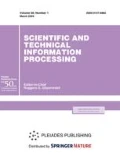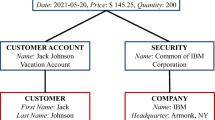Abstract
Digitization encourages accumulation of web content, an important resource of economic activity. Despite high level of development of technology of work with web content, the need for significant expenses restricts its use by small businesses. Web content characterized by absence of structure, diversity of sources, and high speed of data flow, is included in the concept of “Big Data”, efficient work with which requires access to financial, computing, and labor resources. The developed and tested methodological approach to use of web content, taking into account capabilities of small business, enables a specialist in any subject area to upload textual information, convert it into a database, and analyze it using widespread or public domain software.


Similar content being viewed by others
Notes
Small and Medium Entrepreneurship National project. https://futurerussia.gov.ru/maloe-i-srednee-predprinimatelstvo (in Russian).
Tomita-parser (Yandex), ABBYY FlexiCapture, SDK Pullenti (Semantik LLC), IBM SPSS Modeler, EurekaEngine (PalitrumLab LLC).
Kribrum JSC. https://www.kribrum.ru/. Data Analysis Laboratory by Aleksandr Kukushkin LLC. https://lab.alexkuk.ru/.
Natasha library. https://natasha.github.io/ner/.
Superjob. https://www.superjob.ru/z/.
MyStem. https://yandex.ru/dev/mystem/.
Stop words list. https://www.artlebedev.ru/yandex/site/saved/ stopword.html.
REFERENCES
Ananyin, V.I., Zimin, K.V., Lugachev, M.I., Gimranov, R.D., and Skriprin, K.G., Digital organization: Transformation into the new reality, Bus. Inf., 2018, no. 2, pp. 45–54. https://doi.org/10.17323/1998-0663.2018.2.45.54
Moazed, A. and Johnson, N.L., Modern Monopolies, What It Takes to Dominate the 21st Century Economy, New York: St. Martin’s Press, 2016.
Tapscott, D., Macrowikinomics, Rebuting Business and the World, Penguin, 2012.
Lugachev, M.I. and Skripkin, K.G., Information revolution: The economic aspect, Vestn. Mosk. Univ., Ser. 6, Ekon., 2019, no. 6, pp. 20–38.
Abdrakhmanova, G.I., Vishnevskii, K.O., Gokhberg L.M., et al., Indikatory tsifrovoi ekonomiki: 2020. Statisticheskii sbornik (Indicators of the Digital Economy: 2020. Statistical Yearbook), Moscow: Nats. Issled. Univ. Vyssh. Shk. Ekon., 2020, p. 196. https://www.hse.ru/primarydata/ice2020.
Mar, B. and Ward, M., Artificial Intelligence in Practice: How 50 Successful Companies Used AI and Machine Learning to Solve Problems, United Kingdom: John Wiley & Sons, 2019.
Mytenkov, S.S. and Markova, E.S., In pursuit of the digital future: Analysis of the effectiveness of small and medium-sized businesses in the field of ICT for the implementation of the program “Digital Economy of the Russian Federation,” Biz. O-vo. Vlast’, 2018, no. 2, pp. 159–174.
Nissen, V., Lezina, T., and Saltan, A., The role of IT-management in the digital transformation of Russian companies, Foresight STI Gov., 2018, vol. 12, no. 3, pp. 53–61. https://doi.org/10.17323/2500-2597.2018.3.53.61
Stolypin Institute of Economic Growth, Sector of Small and Medium-Sized Enterprises: Russia and the World, 2018. https://stolypin.institute/novosti/sektor-malogo-i-srednego-predprinimatelstva-rossiya-i-mir/. Cited January 18, 2021.
Li, Y. and Rama, M., Firm Dynamics, Productivity Growth, and Job Creation in Developing Countries: The Role of Micro- and Small Enterprises, Oxford Univ. Press on behalf of the World Bank, 2015. https://openknowledge.worldbank.org/handle/10986/24807. Cited January 18, 2021.
Filimonova, N.M., Morgunova, N.V., and Si-nyavskii, D.A., Determination of promising directions for the study of small and medium-sized businesses, Nauchno-Tekh. Inf., Ser. 1, 2014, no. 9, pp. 20–26.
Smirnykh, L.I., Digital literacy of the elderly and digitalization of enterprises: Experience of European countries, Vopr. Ekon., 2020, no. 12, pp. 104–124.
Syuntyurenko, O.V., The risks of the digital economy: Information aspects, Sci. Tech. Inf. Process., 2020, vol. 47, no. 2, pp. 104–112. https://doi.org/10.3103/S0147688220020082
World Bank Group, World Development Report 2016: Digital Dividends, Washington, DC: World Bank, 2016. https://openknowledge.worldbank.org/handle/10986/ 23347. Accessed January 18, 2021.
Gavrilova, T.A., Kudryavtsev, D.V., and Kuznetsova, A.V., The choice of knowledge management tools taking into account the specifics of the subject area, Innovatsii, 2019, no. 8, pp. 44–52. https://doi.org/10.26310/2071-3010.2019.250.8.007
Belonogov, G.G., Gilyaresvkii, R.S., Seletkov, S.N., and Khoroshilov, A.A., Ways to improve the quality of textual data searches on the internet, Autom. Doc. Math. Linguist., 2013, vol. 47, no. 4, pp. 111–120.
Syuntyurenko, O.V., Theoretical and applied aspects of automating multivariate analysis procedures, Autom. Doc. Math. Linguist., 2018, vol. 52, no. 6, pp. 275–281.
Eremenko, K., Rabota s dannymi v lyuboi sfere: Kak vyiti na novyi uroven’, ispol’zuya analitiku (Working with Data in Any Field: How to Reach a New Level Using Analytics), Moscow: Al’pina Pablisher, 2019.
Batura, T.V. and Bakieva, A.M., Metody i sistemy avtomaticheskogo referirovaniya tekstov (Methods and Systems for Automatic Text Summarization), Novosibirsk: IPTs NGU, 2019. https://www.iis.nsk.su/files/ book/file/Batura_Bakiyeva_Autosummarization.pdf.
Tarasov, S.D., Modern methods of automatic abstracting, Nauchno-Tekh. Vedomosti S.-Peterb. Gos. Politekh. Univ., Inf. Telekommun. Upr., 2010, no. 6, pp. 59–74.
Batura, T.V., Methods for automatic classification of texts, Program. Prod. Sist., 2017, vol. 30, no. 1, pp. 85–99.
Efremova, M.I., Automatic parsing and annotation of articles, Fundam. Issled., 2015, no. 2, pp. 4866–4870.
Dneprovskaya, N.V., Investigation of the transition of an enterprise to the digital economy, Vestn. Ross. Ekon. Univ. im. G. V. Plekhanova, 2019, no. 4, pp. 54–65.
Kalabikhina, I.E. and Chesnokov, A.A., Using content analysis of communications in an online consultant to improve customer experience, Gos. Upr., Elektron. Vestn., 2020, no. 80, pp. 151–174.
Yatsko, V.A., A system for automatic analysis of customer opinions, Prikl. Inf., 2015, no. 4, pp. 5–17.
Tverdokhlebova, M.D., Skorobogatykh, I.I., Musatova, Zh.B., and Nevostruev, P.Yu., Assessment of consumer preferences with the use of user content analysis using the example of electronic book products, Mark. Issled., 2020, no. 3, pp. 190–202.
Mosyagin, A.B., Using the data mining methodology in solving the problems of processing social data, Monit. Obshch. Mneniya: Ekon. Sots. Peremeny, 2015, no. 3, pp. 143–146.
de Vries, E., Schoonvelde, M., and Schumacher, G., No longer lost in translation: Evidence that Google Translate works for comparative bag-of-words text applications, Polit. Anal., 2018, vol. 26, no. 4, pp. 417–430.
Bengfort, B., Bilbro, R., and Ojeda, T., Applied Text Analysis with Python: Enabling Language-Aware Data Products with Machine Learning, O’Reilly Media, Inc., 2018.
Segalovich, I., A fast morphological algorithm with unknown word guessing induced by a dictionary for a web search engine, Proceedings of the International Conference on Machine Learning; Models, Technologies and Applications (June 23–26, 2003), Las Vegas, pp. 273–280.
Federal State Statistics Service. Information Society. Information and Communication Technologies. https://rosstat.gov.ru/folder/14478. Cited January 18, 2021.
Federal State Statistics Service. Labor Market, Employment, and Wages. https://rosstat.gov.ru/labor_market_employment_salaries. Cited January 18, 2021.
Veduta, E.N. and Dzhakubova, T.N., Big Data and economic cybernetics, Gos. Upr., Elektron. Vestn., 2017, no. 63, pp. 43–66.
Shevtsova, I.V., Methods for teaching to work with digital data, Otkrytoe Obraz., 2020, vol. 24, no. 4, pp. 32–40.
Shvedov, D.I., Parsing and data matching for operational analysis of dynamic situations, Gorn. Inf.-Anal. Byull., 2017, no. 6, pp. 200–204.
Makushin, A.G. and Osochenko, E.A., Atlas skvoznykh tekhnologii tsifrovoi ekonomiki Rossii (Atlas of End-to-End Technologies of the Digital Economy of Russia), Moscow: AO Grinatom, 2019.
Trotsuk, I., When methodology beats techniques; or, why we prefer discourse and narrative analysis to interpret textual data, Russ. Soc. Rev., 2015, vol. 14, pp. 48–63.
Author information
Authors and Affiliations
Corresponding author
About this article
Cite this article
Dneprovskaya, N.V., Shevtsova, I.V. Methodological Approach to Use of Web Content by Small Business. Sci. Tech. Inf. Proc. 48, 78–86 (2021). https://doi.org/10.3103/S0147688221020040
Received:
Published:
Issue Date:
DOI: https://doi.org/10.3103/S0147688221020040




